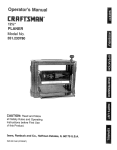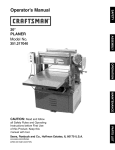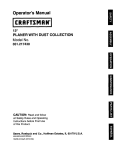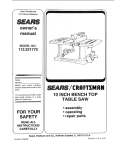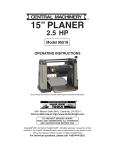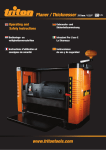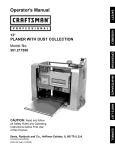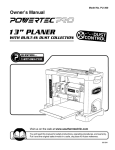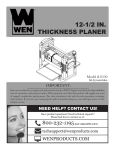Download Craftsman 351.217130 Operator`s manual
Transcript
Operator's Manual 113 RI:IFTSMI:IN° THICKNESS / PLANER Model No. 351.217130 CAUTION: Read and follow all Safety Rules and Operating Instructions before First Use of this Product. Sears, Roebuck and Co., Hoffman 16318.00 Draft (02/05/00) Estates, IL 60179 U.S.A. PREPARE • Do not use power tools in dangerous environments. 3 • Do not use power tools in damp or wet locations. Do not expose power tools 1o rain. • Work area should be properly lighted. • Proper electrical receptacle should be available for tool. Three prong plug should be plugged directly into properly grounded, three-prong receptacle. • Extension cords should have a grounding prong and the three wires of the extension cord should be of the correct gauge. • Keep visitors at a safe distance from work area. • Keep children out of workplace. Make workshop childproof. Use padlocks, master switches or remove switch keys to prevent any unintentiona_ use of power tools. Assembly ................................ 3-4 Installation ............................... 4-7 ......................... Parts Illustration and List .................. FULL ONE YEAR JOB 2-3 Unpacking ................................. Troubleshooting FOR Keep work area clean. Cluttered work areas invite accidents. 2 Operation ................................ Maintenance ............................ AREA • Warranty .................................. Safety Rules .............................. WORK 7-9 9-11 12-13 14-19 WARRANTY tf this product fails due to a defect in material or workmanship within one year from the date of purchase, Sears will at its option repair or replace it free of charge. TOOL SHOULD BE MAINTAINED • Always unplug tool prior to inspection. Contact your nearest Sears Service Center to arrange for product repair, or return this product to place of purchase for replacement. • Consult manual for specific maintaining and adjusting procedures. • Keep toot lubricated and clean for safest operation. If this product is used for commercial or rental purposes, this warranty will apply for 90 days from the date of purchase. • Remove adjusting tools. Form habit of checking to see that adjusting tools are removed before switching machine on. This warranty gives you specific legal rights and you may also have other rights which vary from state to state. • Keep all parts in working order. Check to determine that the guard or other parts will operate properly and perform their intended function. Sears, Roebuck and Co., Dept. 817WA, Hoffman Estates, IL 60179 • Check for damaged parts. Check for alignment of moving parts, binding, breakage, mounting and any other condition that may affect a tool's operation. • A guard or other part that is damaged should be properly repaired or replaced. Do not perform makeshift repairs. (Use parts list provided to order replacement parts.) WARNING: For your own safety, read all of the rules and precautions before operating tool. CAUTION: Always follow proper operating procedures as defined in this manual even if you are familiar with use of this or similar tools. Remember that being careless for even a fraction of a second can result in severe personal injury. BE PREPARED KNOW HOW TO USE TOOL FOR JOB • Wear proper apparel. Do not wear loose clothing, gloves, neckties, rings, bracelets or other jewelry which may get caught in moving parts of machine. • Wear protective hair covering to contain long hair. • Wear safety shoes with non-slip soles. • Wear safety glasses complying with United States ANSI Z87.1. Everyday glasses have only impact resistant lenses. They are NOT safety glasses. • Wear face mask or dust mask if operation is dusty. • Be alert and think clearly. Never operate power tools when tired, intoxicated or when taking medications that cause drowsiness. 2 • Use right tool for job. Do not force tool or attachment to do a job for which it was not designed. • Disconnect tool when changing blades. • Avoid accidental start-up. Make sure that the switch is in the "off" position before plugging in. • Do not force tool. It will work most efficiently at the rate for which it was designed. • Keep hands away from moving parts and cutting surfaces. • Never leave tool running unattended. Turn the power off and do not leave tool until it comes to a complete stop. • Do not overreach. Keep proper footing and balance. • Never stand on tool. Serious injury could occur if tool is tipped or if blade is unintentionally contacted. • Know your tool. Learn the tool's operation, application and specific limitations. • Use recommended accessories (refer to page ??). Use Of improper accessories may cause risk of injury to persons. Handle workpiece correctly. Protect hands from possible injury. • Turn machine off if it jams. Blade jams when it digs too deeply into workpiece. (Motor force keeps it stuck in the work.) • • Always keep drive, cutterhead and blade guards in place and in proper operating condition. • WARNING: Do not attempt assembly if parts are missing. Use this manual to order replacement parts. INSTALL HANDLE Refer to Figures 2, and 3. • Handle with knob (A) can be installed either to top-right or top-left side of the planer. • Remove plug on elevation screw (B) from the side where handle will be installed. Feed work into blade or cutter against direction of rotation. CAUTION: Think safety! Safety is a combination of operator common sense and alertness at all times when tool is being used. WARNING: Do not attempt to operate tool until it is completely assembled according to the instructions. Refer to Figure 1 below. Check for shipping damage, if damage has occurred, a claim must be filed with carrier. Check for completeness. Immediately report missing parts to dealer. The planer comes assembled as one unit. Additional parts which need to be fastened to planer should be located and accounted for before assembling. A. Planer B. Handle with Knob C. 6mm Flat Washer D. 6-1+0 x 25mm Socket Head Bolt E. Pointer Figure 2 - Install Handle • Insert handle with knob (A) onto elevation screw top (B). F. Magnet (2) G. T-wrench Figure 3 - Secure Handle • Position the pointer (E) and washer (D) on the handle. • Secure handle using bolt (C) using the wrench provided. Figure I - Unpacking 3 UNWRAP LINE CORD • Refer to Figure 4. • The line cord (A) is securely wrapped around cord wraps (B), on the rear of the planer. Base of planer has four mounting holes (A). Holes form a rectangle 12" x 20". Use a square to mark )osition on work surface, r : t Aia ...........................-\, Figure 6 - Mount Planer • If pra-drilled holes do not exist on work surface, drill four holes to form a 12 x 20" rectangle. • Securely mount planer to work surface by bolting (not supplied) it through the holes. Figure 4- Unwrap Line Cord • Gently pull line cord to release cord clamp and unwrap line cord POWER INSTALL MAGNETS AND WRENCH WARNING: Do not connect planer to the power source until all assembly steps have been completed. Refer to Figure 5. • SOURCE Magnets (A) and wrench (B) are installed on tool tray (C) on the rear of the planer. The motor is designed for operation on the voltage and frequency specified. Normal loads will be handled safely on voltages not more than 10% above or below specified voltage. Running the unit on voltages which are not within range may cause overheating and motor burnout. Heavy loads require that voltage at motor terminals be no less than the voltage specified on nameplate. • Power supply to the motor is controlled by a switch with key. Removing the key from switch will lock the unit and prevent unauthorized use. GROUNDING INSTRUCTIONS WARNING: Improper connection of equipment grounding conductor can result in the risk of electrical shock. Equipment should be grounded while in use to protect operator from electrical shock. • Check with a qualified electrician if you do not understand grounding instructions or if you are in doubt as to whether the tool is properly grounded. • This tool is equipped with an approved cord rated at 150V and a 3-prong grounding type plug (see Figure 7) for your protection against shock hazards. Figure 5 - Install Magnets and Wrench • Press T-Wrench on the slot on tool tray. • Press magnets into holes on tool tray. MOUNT PLANER TO WORK • SURFACE Refer to Figure 6. • Planer is designed to be portable so it can be moved to job site, but should be mounted to stable, level bench or table. See Recommended Accessories, page 17. Grounding plug should be plugged directly into properly installed and grounded 3-prong groundingtype receptacle, as shown (see Figure 7). Properly Grounded Outlet\ Grounding Prong 3-Prong Plug __ Figure 7 - 3-Prong Receptacle 4 F-_ "_ =.L_ II • accept the tool plug. Do not remove or alter grounding prong in any manner. In the event of a malfunction or breakdown, grounding providesa path of least resistance for electrical shock. • WARNING: Do nat permit fingers to touch the terminals of plug when installing or removing from outlet. • MOTOR Planer is supplied with a 2'/," HP motor installed. Plug must be plugged into matching outlet that is properly installed and grounded in accordance with all local codes and ordinances. Do not modify plug provided. If it will not fit in outlet, have proper outlet installed by a qualified electrician. • Inspect tool cords periodically, and if damaged, have repaired by an authorized service facility. • Green (or green and yellow) conductor in cord is the grounding wire. If repair or replacement of the electric cord or plug is necessary, do not connect the green (or green and yellow) wire to a live terminal. The 120 Volt AC universal motor has the following specifications: Hertz .................................... 60 Single 8000 CONNECTIONS Make sure unit is turned off and discon- The motor is installed and wiring connected as illustrated in the wiring schematic (see Figure 9). Switch " _ ........ TOPower Circuit Breaker To Motor IITo AKnown Figure 9 -Wiring Schematic The motor is assembled with an approved three conductor cord to be used on 120 volts as indicated. The power supply to the motor'is controlled by a double pole locking switch. Receptacle Figure 8 - 2-Prong Receptacle with Adapter • Do not use a 3-prong to 2-prong grounding adapter unless permitted by local and national codes and ordinances. (A 3-prong to 2-prong grounding adapter is not permitted in Canada.) The power lines are inserted directly onto the switch. The green ground line must remain securely fastened to the frame to properly protect against electrical shock. A manual reset overload protector is installed in line with the power supply to the motor. If the planer is overloaded, the protector will break the circuit. Where a 3-prong to 2-prong grounding adapter is permitted, the rigid green tab or terminal on the side of the adapter must be securely connected to a permanent electrical ground such as a properly grounded water pipe, a properly grounded outlet box or a properly grounded wire system. OPERATING ON/OFF CONTROLS SWITCH The ON/OFF switch (A) is located on the front of the planer motor. To turn the planer ON, move the switch to the up position. To turn the planer OFF, move the switch to the down position. Many cover plate screws, water pipes and outlet boxes are not properly grounded. To ensui'e proper ground, grounding means must be tested by a qualified electrician. CORDS • The use of any extension cord will cause some drop in voltage and loss of power, • Wires of the extension cord must be of sufficient size • 15. _Ma(_erSnerdThis _.2-Prong • 120 Amperes ................................. nected from power source before inspecting any wiring. 3Proo0 o,ou n0 EXTENSION Voltage ................................. WARNING: A temporary 3-prong to 2-prong grounding adapter (see Figure 8) is available for connecting plugs to a two pole outlet if it is properly grounded. • 2'/," ELECTRICAL WARNING: Any receptacle replacement should be performed by a qualified electrician. Adapter Horsepower (Maximum Developed) ............ Phase ................................ RPM .................................. • A 2-prong wall receptacle must be replaced with a properly grounded 3-prong receptacle installed in accordance with National Electric Code and local codes and ordinances. GroundingLug _ If the extension cord is worn, cut or damaged in any way, replace it immediately. : ',_--I_)_/_ A to carry the current and maintain adequate voltage. The minimum extension cord wire size is A.W.G. 14. Do not use extension cords over 25 feet long. Use only 3-wire extension cords having 3-prong grounding type plugs and 3-pole receptacles which Figure 10 - ON/OFF Switch 5 _i ! SWITCH LOCK +--, -,( .... B Refer to Figure 11. The planer can be locked from unauthorized use by locking the switch. To lock the switch: • Turn the switch to OFF position and disconnect planer from power source. • Pull the key (A) out. The switch can not De turned ON with the key (A) removed. +c NOTE: Should the key (A) be removed from the switch at the ON position+the switch can be turned OFF but cannot be turned ON. A ¸ A f _/¸ i _ '_D . ..+/= : Figure 12 - Raise/Lower Rollercase :i- DEPTH-OF-CUT GAUGE Refer to Figure 12. -J" B A spring loaded depth-of-cut gauge (D) is attached on to front of rellercase. The pointer on depth-of-cut gauge accurately displays the rollercase height set-up when workpiece is positioned below the gauge. Cranking the handle moves the rollercase down and the pointer shows increased depth-of-cut up to W' Figure 11 - Switch Lock and Circuit Reset • To replace key, slide key into the slot on switch until it snaps. CIRCUIT Recommended Maximum Depth-Of.Cut: Hard/Softwood upto 6" wide: ................. Hard/Softwood 6-1 3" wide: ..................... BREAKER CAUTION: A _/_" depth-of -cut on hard, softwood Refer to Figure 11. 6-13" wide can be made. However, continuous operation at this set-up can cause premature motor failure. The planer is equipped with a motor protection devicecircuit breaker. The breaker will automatically shut the planer off when excessive current is consumed. WORKPIECE If the breaker is tripped, turn the planer "off" and reset the circuit by pressing the button (B). AND LOWERING THICKNESS GAUGE Refer to Figure 13. A five position workpiece thickness gauge (A) is mounted on rollercase. This gauge allows to preset the desired finished workpiece thickness that the planer will produce. Five setting are provided: %', 1/2",1" and 11/," CAUTION: Be sure to turn the planer "off" prior to resetting the circuit breaker to avoid unintentional startup of the planer. RAISING 3/32,, ,/,,,, ROLLERCASE Refer to Figure 12. The rollercase (A) contains the motor, cutterhead and chip deflector. The depth-of-cut is controlled by raising or lowering the roltercase. Rotate handle with knob (B) to raise or lower rellercase. NOTE: One complete rotation of handle will raise or lower rollercase by approximately '/,_" A rotational direction label with depth indicator is provided on either sides of the planer top. The English/Metric scale (C) with pointer allows easy adjustment of roller case height. Figure 13 - Workplece Thickness 6 Gauge Example: Plane a 2" thick workpiece up to 1V,". • Raise or lower rollercase until it is just above the workpiece. • Position the workpiece on the planer table below the rollercase. • Depress gauge (A) and rotate until the 1'/," is positioned on the front and facing you. • Release gauge. gauge for convenient set-up, workpiece thickness gauge with 5 settings for consistent set-up, easy hands-free replacement of blades for safety and minimized downtime, top mounted rollers for workpiecs return, built-in carrying handles, cord wraps for portability and folding infeed/outfeed rollers for smooth operation. Planer takes cuts up to s/=,,per pass at 26 feet per minute. Inch height scale has graduations in ¼," increments, and metric height scale has graduations in 1ram increments. • The planer is now set to stop the rollercase when the workpiece thickness reaches 11/," OPERATION SAFETY RULES NOTE: To reset for a different depth stop, gently raise the rollemase by about 2 rotations Depress and turn gauge (A) to desired set-up. CUTTERHEAD WARNING: For your own safety, read all of the instructions and precautions before operating tool. WARNING: Operation of any power tool can result in LOCK foreign objects being thrown into eyes which can result in severe eye damage. Always wear safety goggles complying with United States ANSI Z87.1 (shown on package) before commencing power tool operation. Refer to Figure 14. The planer cutterhead can be locked from any movement during planing in order to guarantee uniform thickness. To lock cutterhead, pull down on lever (A). CAUTION: cautions: Always observe the following safety pre- • Know general power tool safety. Make sure all precautions are understood (see pages 2, 3 and 7). • Whenever adjusting or replacing any parts on planer, turn switch off and remove plug from power source. • Make sure all guards are properly attached and securely fastened. • Make sure all moving parts are free from interference. • Always wear eye protection or face shield. • Make sure blades are aligned and properly attached to cutterhead. A Do not plug in planer unless switch is in "off" position. After turning switch on, allow planer to come to full speed before operating. ® Keep hands clear of all moving parts. Figure 14 - Cutterhead Lock Do not force cut. Slowing or stalling will overheat motor. Allow automatic feed to function properly. To release cutterhead, gently push up lever (A) NOTE: The roUercase can be raised or lowered when Use quality lumber. Blades last longer and cuts are smoother with good quality wood. the cutterhead is locked by exerting excessive pressure on handle. However, cranking the handle when the cutterhead is locked will wear down the locking mechanism prematurely. Do not plane material shorter than 15", narrower than 3/_,,wider than 13" or thinner than ½". Never make planing cut deeper than 3/_,, Maintain the proper relationships of infeed and outfeed table surfaces and cutterhead blade path. Do not back the work toward the infeed table. DESCRIPTION Take precautions against kickback. Do not permit anyone to stand or cross in line of cutterhead's rotation. Kickback or thrown debris will travel in this direction. Craftsman 13" planer finishes rough-cut lumber to size and planes soft and hardwoods up to 6" thick and 13" wide. Wood feeds into two-blade cutterhead by rubber infeed/outfeed rollers. Sturdy base construction and four-post design permits smooth feeding and virtually snipeless planing. Planer comes with enclosed, universal ball bearing, 2_/2HP (max. developed) motor with overload protection. Motor has ON/OFF switch with removable key to prevent accidental start-up. Unit features cutterhead lock for uniform thickness, depth-of-cut Turn switch off and disconnect power whenever planer is not in use, Replace knives as they become damaged or dull. Keep planer maintained. Follow maintenance instructions (see pages 9 -11). 7 DEPTH OF CUT AVOID DAMAGE TO BLADES Thickness, planing refers to the sizing of lumber to a desired thickness while creating a level surface parallel to the opposite side of the board. Board thickness which the planer will produce is indicated by the scale (A), and depth-of-cut-gauge (B). Preset the planer to the desired thickness of finished workplace using gauge (E). See =Workpiece Thickness Gauge", page 6. • Thickness planer is a precision woodworking machine and should be used on quality lumber only. Do not plane dirty boards; dirt and small stones are abrasive and will wear out blade. • • Remove nails and staples. Use planer to cut wood only. • Avoid knots. Heavily cross-grained wood makes knots hard. Knots can come loose and jam blade. CAUTION: Any article that encounters planer blades may be forcibly ejected from planer creating risk of injury. PREPARE WORK • Thickness planer works best when lumber has at least one flat surface. Use surface planer or jointer to create a flat surface. Twisted or severely warped boards can jam planer. Rip lumber in half to reduce magnitude of warp. Work should be fed into planer in same direction as the grain of the wood. Sometimes grain will change directions in middle of board. In such cases, if possible, cut board in middle before planing so grain direction is correct. CAUTION: Do not plane board which is less than 15" long; force of cut could split board and cause kickback. Figure 15- Depth-Of-Cut FEEDING Depth-of-cut is adjusted by raising or lowering the rollemase (C) using handle (D). The planer is supplied with planing blades mounted in the cutterhead and infeed and outfeed rollersadjusted to the correct height. Planer feed is automatic; it will vary slightly depending on type of wood. • Feed rate refers to rate at which lumber travels through planer. • Quality of thickness planing depends on the operator's judgement about the depth of cut. Depth of cut depends on the width, hardness, dampness, grain dire_ion and grain structure of the wood. • Maximum thickness of wood which can be removed in one pass is 3/_,,for planing operations on workpiece up to 6" wide. Workplace must be positioned away from the center tab on the rollercase to cut _=". • Maximum thickness of wood which can be removed in one pass is 1/16"for planing operations on workpiece from 6" up to 13" wide. • For optimum planing performance, the depth of cut should be less than ¼6". • Board should be planed with shallow cuts until the work has a level side. Once a level surface has been created, flip the lumber and create parallel sides. Plane alternate sides until the desired thickness is • obtained. When half of total depth of cut is taken from each side, the board will have a uniform moisture content and additional drying will not cause it to warp. • WORK • Operator is responsible for aligning work so it will feed properly. • Raise/lower rollercase to produce the depth of cut desired. • Stand on side to which the handle is attached. I \ Depth of cut should be shallower when work is wider. • When planing hardwood, take light cuts or plane the wood in thin widths. • Make a test cut with a test piece and verify the thickness produced. • Check accuracy of test cut prior to working on finished product. Figure 16- Feeding Work • 8 Boards longer than 24" should have additional support from free standing material stands. • Position the workpiece with the face to be planed on top. • Turn the planer ON. • Rest board end on in-feed roller plate and direct board into planer. • Gently slide workpiece into the infeed side of the planer until the infeed roller begins to advance the workpiece. • Planer will operate best if kept in good condition and properly adjusted. CHECK FOR WORN BLADES Let go of the workpiece and allow automatic feed to advance the workpiece. • Do not push/pull on workpiece. Move to the rear and receive planed lumber by grasping it in same manner as it was fed. CAUTION: To avoid risk of injury due to kickbacks, do not stand directly in line with front or rear of planer. • Do not grasp any portion of board which has not gone past out-feed roller. • Repeat this operation on all boards which need to be same thickness. • Condition of blades will affect precision of cut. Observe quality of cut which planer produces to check condition of blades. • Dull blades will tear, rather than sever wood fibers and produce fuzzy appearance. • Raised grain will occur when dull blades pound on wood that has varying density. Raised edge will also be produced where blades have been nicked. REPLACE BLADES WARNING: Always turn planer OFF and disconnect from power source before starting any maintenance work. • Loosen and remove socket head bolts (A) from chip deflector (B) on the rear side of planer. Remove chip deflector. • Surface that the planer will produce will be smoother if shallower depth of cut is used. Avoiding • Figure 18 - Remove Chip Deflector Snipe Snipe refers to a depression at either end of board caused by an uneven force on cutterhead when work is entering or leaving planer. • Carefully turn cutterhead by hand towards you until it is stopped by the self-engaging latch. • Loosen and remove six bolts from gib (C). • Snil_e will occur when boards are not supported properly or when only one feed roller is in contact with work at beginning or end of cut. • To avoid snipe, gently push the board up while feeding the work until the ouffeed roller starts advancing it. • Move to the rear and receive planed board by gently pushing it up when the infeed roller looses contact with the board. • When planing more than one board of the same thickness, butt boards together to avoid snipe. • Snipe is more apparent when deeper cuts are taken. • Feed work in direction of grain. Work fed against grain will have chipped, splintered edges. Figure 19 - Remove Gib Bolts 9 • Remove gibusing two magnets (D) provided. BRUSH INSPECTION AND REPLACEMENT WARNING: Turn planer off and disconnect from power source. Brush life depends on amount of load on motor. Regularly inspect brushes after 100 hours of use. Brushes are located on either side of planer motor. \ _ ,Figure 20 - Remove GIb t! -- . i I NOTE: Magnets can be easily disengaged from gib by tilting them to left or right. CAUTION: Blade edges are extremely sharp. Keep fingers away from blades at all times. • Blade is held on position by two pins. Gently lift old blades from the pin using the two magnets. "Do not make contact with the blade using fingers. Use magnets only". Figure • 22 Replace Brushes -_ ' ..... Loosen brush holder (A) and gently remove brush from motor. NOTE: Brushes are located on both front and rear sides of planer. • Replace spring (B) if damaged, • Replace carbon (C) if worn. • Replace brushes and tighten brush holder. ADJUSTING TABLE LEVEL Refer to Figures 24 and 25. The planer will produce uneven depth of cut (tapered cut) if the rollercase (Fig. 25, Key No. 26) is not parallel with the base (Fig. 24, Key No. 43). To restore parallelism of the rollercase with the base: • Using a test piece, measure the height of the taper. • Turn planer OFF and disconnect form power source. • Fold the front and rear extension tables. • Replace with new blade and carefully position it on the two pins using the two magnets. • Replace gib and align the holes on the gib with holes on the blade using the two magnets. • Secure gib to cutterhead using six bolts removed earlier. • Depress latch to release cutterhead. Release latch when cutterhead can be turned by hand. • Turn cutterhead by hand until it is stopped by selfengaging latch. • Lay the planer carefully on it's back so that the bottom side of the base is facing you. • Clamp a vise plier (not supplied) on the left side of shaft (Fig. 24, Key. No. 31) next to the gear (Fig. 24, Key. No. 20). • Remove retaining ring (Fig. 24, Key. No. 30) and disengage right gear from the top gear (Fig. 24, Key. No. 20). • Slowly rotate handle (Fig. 24, Key. No. 11) to raise or lower rollercase. Rollercase will move by 0.004" with every turn of the gear by one tooth. Move rollercase to the required distance to offset the taper. • Remove gib and blade as mentioned earlier. • Replace with new blade and replace gib and secure it as mentioned earlier. • Re-engage the right and top gear and replace retaining ring to secure. • Replace chip deflector and secure it using two bolts. • Release and remove vise plier. 10 • Set the planer back on it's base. LUBRICATION • • Motor and cutterheed bearings are sealed and need no lubrication. • Gears and elevation screws should be cleaned of debris and greased. The base cover can be coated with a lubricant such as furniture wax, to make the workpiece feed smoother. Be sure the lubricant used does not affect Make a test cut to verify adjustment. REPLACING V-BELT Refer to Figures 23, 24 and 25. Inadequate tension in the V-belt (Fig. 25, Key No. 84) will cause the belt to slip from the motor pulley (Fig. 24, Key. No. 24) or drive pulley (Fig. 25, Key No. 85). Loose belt must be replaced. To replace V-belt: • Turn planer off and unplug from power source. • Loosen and remove screws (Fig. 24, Key. Nos. 3 and 4) on right panel (Fig. 24, Key. No. 14). Remove panel. • the ability to finish the workpiece with varnish, sealer, etc. Do not use any silicone base lubricants. CLEAN • PLANER Keep planer clean of any wood chips, dust, dirt or debris. • Remove old belt by walking the belt from motor and drive pulleys alternatively. Gently pull the belt while turning the pulleys at the same time. • After 10 hours of operation, the chains and gears should have wood chips, dust and old grease removed. • Replace with new belt. Walk the belt on to the pulleys in the reverse manner as when removing the belt. • • Make sure the belt is evenly seated all the way on the motor and drive pulleys grooves. • Replace and secure right panel. DUST COLLECTOR CHIP CHUTE Refer to Figure 25. Planer is best used along with a dust collector. A dust collector chip chute (not shown) is available as an optional accessory. The dust chute has a fitting for attaching a 4" hose. A 4" to 2'/2" adapter is also available (see Recommended Accessories, page 17). The dust collector chip chute is mounte/d_tothe planer in place of the chip deflector (Key. No._). To mount dust collector chip chute: • Turn planer OFF and unplug from power source. • Loosen end remove two socket head bolts (Key No. 7). • Remove chip deflector. • Slide dust collector chip chute along the inside walls of rollercase (Key No. 26), so that the slots on the dust chute are aligned above the holes on the rollercase. • Reuse two socket head bolts to secure dust chute with rollercase. After mounting, attach a 4" (outside diameter) dust collector hose to the dust chute fitting. If dust collector chip chute is used with the 4" to 2'/2" adapter, attach a 2'/2" hose to the adapter. Be sure to turn the vacuum ON before operating the planer. 11 Use common automotive bearing grease to lubricate all chains and gears. Be sure all chains and gears have plenty of grease. ;YMPTOM i POSSIBLE CAUSE(S) i CORRECTIVE ACTION / Snipe (gouging at ends of board) i l.Dull blades I 1. Replace blades per instructions. See "Maintenance." 12. Inadequate support of long boards t 2.Support long boards. See "Avoiding Snipe? 3.Uneven force on cutterhead 13.Gently push board when board is in contact I with only one feed roller. See "Avoiding Snipe._ i 4.Adjust rollercase. 4.Rollercase not level with base I See "Adjusting Table Level." _5.Butt end to end each piece of stock as boards pass through planer. 5.Lumber not butted properly J Fuzzy grain P an ng wood with a high moisture ! content Torn grain Rough raised grain 1.Too heavy a cut 2.Blades cutting against grain 11.Review "Depth of Cut." 2.Review "Feeding Work: 3.Dull blades ! 3.Rep ace blades per instructions. See "Maintenance? 1.Dull blades I 1.Replace blades per instructions. 2.3"ooheavy a cut 3.Moisture content too high See "Maintenance." 12.Rev ew "Depth of Cut" ! 3.Dry the wood or use dried wood. Cutterhead not level with planer base Uneven depth of cut side to side) Rollercase elevation adjusts with difficulty i Remove high moisture content from wood by _, drying. ,1.Gears dirty 2. Elevation screws dirty 3.Gears, elevation screws worn 4.Fricticn between rotiercase and i covers 5.Rol ercase not parallel with planer base 6.Cutterhead lock engaged Board feeds inside, but stops 11.0utteed rotters cannot rotate due moving past the outfeed roller i to clogging of chips 12:Too much pressure on the 1 cutterhead from long workpiece i Rollercase not level. See "Adjusting Table Level." 1.Clean and lubricate gears. 2.Clean and lubricate elevation screws. 3.Replace gears, elevation screws. 4.Clean and lubricate. 5.Adjust rollercase. See "Adjusting Table LeveL" 6.Release cutterhead lock 1.Clear the clogging, use dust collector chip chute. See "Recommended Accessories." 2.Use support stands to support workpiece longer than 24". See "Recommended Accessories." Board thickness does not match depth of cut scale ! Indicator not set correctly _Adjust indicator and tighten securely. Chain jumping il .Sprockets worn 2.Chain worn ! 1.Replace sprockets. ,2.Replace chain. .............will not operate Planer _1 .No power ........ to planer 2.Motor overload protection tripped 1.Check power sourceby ; Belt sSpping quaSfiedeiectrician_ 2.Turn planer OFF. Reset motor overload protection. See "Overload Reset." 3.Defective or loose switch or wiring 3.Check switch and wiring by qualified electrician. Loose belt Replace belt, see "Replacing V-Belt" Rollercase connect be lowered Workpiece thickness gauge setting , restricts roUercase movements 12 Reset thickness gauge setting See "Workpiecel .Thickness Gauge" NOTES 13 Model 351.21 7130 Figure 23 - Replacement Farts lllustmtlon for Motor 7 8 6 _" 12 ,/ 13 17 22 19 20 23 25 24 14 KEY NO. T PART NO. - DESCRIPTION ........ QTY. ................................... i-- 2 16081.00 4-1.59 x 12ram Threaded Forming Screw 2 3 16082.00 Switch Cover 1 4 04287.00 Circuit Breaker 1 5 I 01090,00 _ 16083.00 5-0.8 x 15mm Pan Head Screw Line Cord .................... 2 2 7 16084.00 4-0.7 x 8mm Washer Head Screw 1 8 16085.00 Wire Clip 1 9 16086.00 Housing, Left 1 10 16087.00 Strain Relief 1 11 16088.00 Self Tapping Screw 4 12 16089.00 Cap 1 13 STD315215 16090.00 6200 Ball Bearing* Armature With Fan 1 14 15 16091.00 Self Tapping Screw 2 16 STD315216 6201 Ball Bearing* 1 17 16092.00 1 18 04283.00 Fan Casing Stator 19 16093.00 Housing, Right Brush Holder 1 20 03866.00 _- T03867.00 _ Car/:)onBrussl_-(s_-of2) 1 1 2 ........................................ 1 -- 22 03868.00 Brush Cap 2 23 STD502503 '/,-20 x %" Set Screw* 2 24 03865.00 Motor Pulley 1 25 16094.00 Label 1 Owner's Manual 1 A I 16318.00 i A Standard hardware item available locally Not Shown 15 Model 351.217130 Flgure 24 - Replacement Parts lllustmtlon for Base 3 5 6 2 7 10 16 -_, 15 13 il / 36 o42 39 ; 40 # / _3 F 41 16 KEY ; KEY I ._N_O_L___PART - NO., 1 116095.00 PART NO. DESCRIPTION 121 00221.00 3AMI-10 Retaining Ring : ' 22 ; 03812.00 6-1.0 x 10mm Pan Head Screw ! 4 ; 23 i 24 i 16105.00 16106.00 , 16107.00 Guide Plate Cover Plate 8mm Flat Washer* QTY. ! , 1 2 109631.00 ! Plug ] 1 3 !16096.00 I i 8-1.25 x 16mm Socket Pan Head Screw ; 4 ] i I NO. DESCRIPTION ', Cover QTY. ; ! 2 E L 4 r 16097.00 4-1.59 x 10mm Threaded 116 ; 25 : Forming Screw 6 x 20ram Dowel Pin I ! 2 26 i STD851008 ' 27 28 01882.00 STD840610 _8-1.25 x 20mm Socket Head Bolt 4 i 6-1.0mm Hex Nut* i 4 29 STD833025 _6-1.0 x 25ram Hex Head Bolt* 08323.00 16108.00 , 3CMI-8 Retaining Ring Shaft 5 08338.00 6 7 09637.00 09635.00 8 9 i 16098.00 ;STD851006 i Bushing : Roller 4 ! 2 : Pointer ! 6mm Flat Washer* ; 1 : 1 .30 31 i 1 32 :10 16099.00 6-1.0 x 25mm Socket Pan 11 : 16100.00 Head Screw Handle 12 i 13 14 i15 16!01.00 09636.00 I Grip 6 x 22mm Clevis Pin ,16102.00 Panel 116103.00 ! Column ! 18 _0_.00 i01775 00 06270.00 Z 4 : ' 4 2 1 5-0.8 x 8mm Socket Head Bolt 4 Bracket 2 i r I 1 33 08551.00 34 ' 16109.00 i 2 2 35 36 00781.00 16110.00 : 6 x 25mm Spring Pin 4 4-0.7 x 8mm Pan Head Screw Roller Plate : 112 4 i ' 2 , 4 i 37 16111.00 38 09649.00 Spacer 4 = q 16 i 2 1 ; 4 I=Extension Table 2 i Elevation Screw (left) 6-1.0 x 25mm Socket Head Bolt 19 09656.00 _Set Plate 120 ,09646.00 I j Gear i ; 39 08662.00 6-1.0 x 8mm Socket Head Bolt 4 i 40 09658.00 Bushing 4 _ 2 iI 41 42 16112.00 16113.00 4 43 16326.00 1 T 4 T i Support Roller Elevation Screw (right) i] Base 2 1 1 Standard hardware item available locally : Recommended Accessories iDust Collector Chip Chute 9-23318 = A !Multi-Purpose_ Stand A Horizontal Roller Stand _-22224 ...... , 9-23317 i '_ z_ ;Planer Blade (set of 2) ! A Three-Roler 17 Stand 9-23315 9-22265 Model 351.217130 Figure 25 - Replacement Parts Illustration for Rollercase 4 10 11 21 74 75/ 28 76 18 KEY KEY NO. PART NO. DESCRIPTION QTY. NO. i 16ii4.00' Wrenoh 1 2 16115.00 2 1 6 46 1 i 49 1 15o 3 116116.00 4 5 6 Magnet Tool I Tool Tray 16084,00 16117.00 16118.00 7 4-.07 x 8mm Washer Head Screw Dust Chute with Gasket Chip Deflector 6-1.0 x 12mm Socket Pan 06346.00 DESCRIPTION QTY. 16145.00 i 5 x 5 x 9mm Key 1 46 00519.00 i 3AM1-12 Retaining Ring 2 47 03853.00 i 14 PART NO. 51 00533,00 16146,00 [16147.00 3 Chain Sprocket 3AM1-15 Retaining Ring 5-0.8 x 40mm Socket Head Dolt 'Spring 4 3 1 i16148,00 Shoulder Screw 1 i 52 i16149.00 Chain Cover 1 1 53 16150 O0 Tension Wheel Assembly 1 Head Screw i 8 16119.00 Cutterhead 9 10 16120.00 116121.00 Pin 6 54 15105.00 5-0,8 x 35mm Socket Head Bolt 1 Blade (set of 2) 1 55 i16151.00 Pie 2 11 116122,00 Gib 2 56 16123.00 Pad 4 57 Bushing Gear 36T 4 12 16152.00 16153.00 13 16124.00 Spring 4 58 i16154.00 Gear lOT 2 14 33839.00 5x5xl0mmKey Rod 1 59 4 x 4 x 7mm Key Gearbox 3CMI-8 Retaining Ring 2 6O i16155.00 116156.00 2 4 h6iST.60 Gear 9T Locking Lever Assembly 1 i16158.00 Shaft 1 15 16 16125.00 38323.00 17 16126.00 18 16127.00 19 06086.00 22 23 27 16128.00 16129.00 3 x 8mm Dowel Pin 1 STD840610 6-1.0mm Hex Nut* 1 2 65 01887.00 6-1.0 x 15mm Hex Head Bolt 1 66 i616ii00 Chain 1 4 1 1 67 16162,00 Thickness Gauge t 68 16163.00 Spring 1 69 16164.00 01516.£0 16131.00 Spacer 6 Izo 16165.00 I! 1 1 i71 16166.00 Shoulder Screw Pointer 72 05990.00 3-0.5 x 6mm Pan Head Screw 2 17 73 16167.00 Bracket 1 2 74 03227.00 09661.00 Spring Bracket 2 4 t 4 5-0,8 x 20ram Hex Head Bolt Spring Block 5-0,8 x 8mm Set Screw 16132.00 Rollercase Belt Cover I . 2 i 01784.00 5-.08 x 10mm Pan Head Screw __9 16133.00 5-0.8 x 10ram Washer Head Screw 30 16134.00 Spring t 75 31 16135.00 Latch I 76 16168.00 Roller 2 32 16136.00 Bracket 77 03226.00 33 06270.00 5-0.8 x 8mm Socket Head Dolt 78 16169.00 Spring Pointer 2 1 34 16137.00 Plate 79 STD852006 6mm Lock Washer* 2 35 01474,00 5mm Serrated Washer 1 80 16317.00 6-2.54 x 20mm Threaded 1 6202 Ball Dearing* Knob 1 1 81 31775.00 Forming Screw 6-1.0 x 25mm Socket Head Bolt 1 1 82 STD315235 6203 Ball Bearing* 1 Spacer 1 36 STD315225 37 16138.00 _-1.0 x 12mm Socket Head Bolt 3 36 01505.00 39 ;16139.00 1 83 40 16140.00 Bushing Gear 58T 16318.00 1 84 33841.00 135 Poly V-Belt 41 16141.00 Gear 44T 1 85 03840.00 i 86 03829.00 Drive Pulley 16-1.5mm Hex Nut 1 87 03844.00 Spring 1 88 03843.00 Retaining 42 16142.00 43 _ 44 16143.00 Bushing Gearbox Cover 16144.00 Shaft I 16159.00 64 q 16130.00 25 63 2 I 4-0.7 x 8mm Socket Head Dolt STD851004 4mm Flat Washer 2i 1STD840506 5-6:gHex NUt 1 2 I Cam I 20 1 19 Bracket 4 In U.S.A. or Canada for in-home major brand repair service: Call 24 hours a day, 7 days a week 1-800-4-MY-HOME °_(1-800-469-4663) Para pedir servicio de reparacibn a domicilio - 1-800-676-5811 Au Canada pour tout le service - 1-877-LE-FOYER For the repair or replacement sM(1-877-533-6937) parts you need: Call 6 a.m. - 11 p.m. CST, 7 days a week PartsDirect s° 1-800-366-PART (1-800-366-7278) www.sears.com/partsdirect Para ordenar piezas con entrega a domicilio For the location of a Sears Service Center - 1-800-659-7084 in your area: Call 24 hours a day, 7 days a week 1-800-488-1222 To purchase or inquire about a Sears Maintenance Agreement: Call 7 a.m. - 5 p.m. CST, Monday - Saturday 1-800-827-6655 SEARS HomeCentral so




















